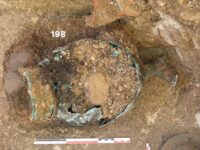 Archaeologists have discovered a rare copper authepsa, a vessel used to heat water, in an excavation around the cathedral of Die in the Drôme department of southeastern France. A team from France’s National Institute for Preventive Archaeological Research (INRAP) was excavating a location on Place de la République where a tree was going to be planted when they unearthed the remains of an ancient building. It was built in the second half of the 1st century and destroyed in a fire at the end of the 2nd century.
Archaeologists have discovered a rare copper authepsa, a vessel used to heat water, in an excavation around the cathedral of Die in the Drôme department of southeastern France. A team from France’s National Institute for Preventive Archaeological Research (INRAP) was excavating a location on Place de la République where a tree was going to be planted when they unearthed the remains of an ancient building. It was built in the second half of the 1st century and destroyed in a fire at the end of the 2nd century.
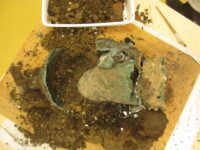 It is 47 cm (18.5 inches) high and consists of two compartments: a reservoir for liquid and a heating chamber. The tank has a capacity of about a gallon and was made of a single very thin (2 mm) piece of copper alloy. The heating chamber runs diagonally from the base of the vessel through the center and is welded to a two-inch hole in the side of the belly through which hot coals were fed to heat the liquid in the reservoir. The opening in the base of the heating chamber is plugged with a copper hemisphere held in place by two transverse iron rods that perforate the base. This blocked the coals from falling out of the chamber while still providing an exit route for the ashes. The vessel was mounted on an annular base with two small square vents.
It is 47 cm (18.5 inches) high and consists of two compartments: a reservoir for liquid and a heating chamber. The tank has a capacity of about a gallon and was made of a single very thin (2 mm) piece of copper alloy. The heating chamber runs diagonally from the base of the vessel through the center and is welded to a two-inch hole in the side of the belly through which hot coals were fed to heat the liquid in the reservoir. The opening in the base of the heating chamber is plugged with a copper hemisphere held in place by two transverse iron rods that perforate the base. This blocked the coals from falling out of the chamber while still providing an exit route for the ashes. The vessel was mounted on an annular base with two small square vents.
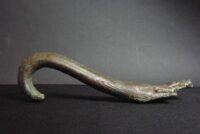 The neck is fashioned into a pouring spout. A cast pouring handle is soldered to the body with a lead-tin mixture. The handle is highly decorative, shaped as dog with his muzzle resting on his front paws. The shape of the vessel and the base is of a type used to heat water for use in personal ablutions. They were easy to carry and could be used out of doors, so it’s also possible it was used to serve a mixture of water and wine.
The neck is fashioned into a pouring spout. A cast pouring handle is soldered to the body with a lead-tin mixture. The handle is highly decorative, shaped as dog with his muzzle resting on his front paws. The shape of the vessel and the base is of a type used to heat water for use in personal ablutions. They were easy to carry and could be used out of doors, so it’s also possible it was used to serve a mixture of water and wine.
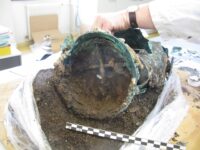 Authepsae of this type are extremely rare. Only six are known to be extant, and this is the second ever found in Gaul. The pot itself can’t be absolutely dated, but the other one discovered in Gaul roughly dates to between the 1st and 3rd century A.D. The unusual dog-shaped handle might held narrow down the date range once it’s cleaned and restored. Some charcoal found in the heating chamber was radiocarbon dated to 130-260 A.D.
Authepsae of this type are extremely rare. Only six are known to be extant, and this is the second ever found in Gaul. The pot itself can’t be absolutely dated, but the other one discovered in Gaul roughly dates to between the 1st and 3rd century A.D. The unusual dog-shaped handle might held narrow down the date range once it’s cleaned and restored. Some charcoal found in the heating chamber was radiocarbon dated to 130-260 A.D.
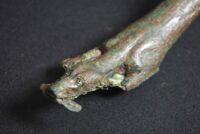 There is archaeological evidence of settlements in the Die area dating back to the Neolithic, but urbanization only kicked off in the 1st century A.D. under Roman rule. By the early 2nd century, Die was a thriving capital of the Gallic Vocontii people and would take on even greater prominence around the turn of the 3rd century as a religious center for the cult of mother goddess Cybele. The authepsa was a luxury item and must have belonged to one of the city’s elite. The room in which it was found had important painted wall decoration, confirming that it was the home of a wealthy person.
There is archaeological evidence of settlements in the Die area dating back to the Neolithic, but urbanization only kicked off in the 1st century A.D. under Roman rule. By the early 2nd century, Die was a thriving capital of the Gallic Vocontii people and would take on even greater prominence around the turn of the 3rd century as a religious center for the cult of mother goddess Cybele. The authepsa was a luxury item and must have belonged to one of the city’s elite. The room in which it was found had important painted wall decoration, confirming that it was the home of a wealthy person.
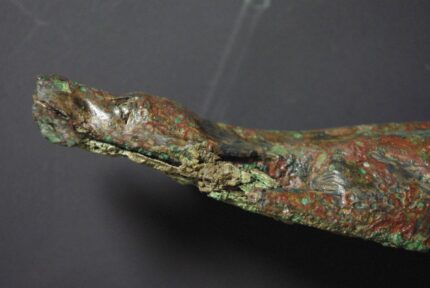
A stove (not) to Die for, or just a Samovar? ..Anyway, I’d rather have a drop of milk with my nice cup of Hot Water 😆
———
“…a house filled with Corinthian and Delian vessels, among which is that authepsa which he has lately sold at so great a price, that passers by, who heard the money being counted out, thought that a farm was being sold…”
“…domus referta vasis Corinthiis et Deliacis, in quibus est authepsa illa quam tanto pretio nuper mercatus est ut, qui praetereuntes quid praeconem numerare audiebant, fundum venire arbitrarentur…” [Cicero]
———
Background:
Sextus Roscius was accused of killing his own father (also called Sextus), who was murdered in the streets of Rome. In late 81 BC, the Roscii family estates were added to the proscription list by Lucius Cornelius Chrysogonus, a powerful freedman of the dictator Sulla. It seems this was done illegally, since the official end-date for the proscriptions had already passed. At the public auction that followed, Chrysogonus himself bought the family estates, reportedly worth over 6 million sesterces, for a meagre 2000 sesterces.
In his defense for Sextus the younger, Cicero argued that those who chose to align themselves with Chrysogonus in the belief that they were supporting the nobility were wrong to do so, since his corruption was a stain on the Republic. Sextus the younger was eventually acquitted of the murder charges.